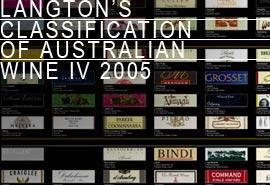 As has been noted by a number of WineBlogs the wine auction house of Langton’s has updated their Classification of Australian Wine. Reviewed every five years the 2005 Classification comprises 101 wines: 11 Exceptional, 22 Outstanding, 34 Excellent and 34 Distinguished. This an increase of 12 from the 89 wines listed in the 2000 Classification, with 67 wines of the 2000 Classification included in the 2005 Classification. The criteria used for selection have not been clearly enunciated by Langton’s but a wine must have 10 vintages to be considered for inclusion. Other criteria include bidding activity, price realizations and volume of wine sold for all wines and vintages sold by Langton’s. Importantly the classification is not based on tastings or show results or even the pronouncements of wine critics or writers.
As has been noted by a number of WineBlogs the wine auction house of Langton’s has updated their Classification of Australian Wine. Reviewed every five years the 2005 Classification comprises 101 wines: 11 Exceptional, 22 Outstanding, 34 Excellent and 34 Distinguished. This an increase of 12 from the 89 wines listed in the 2000 Classification, with 67 wines of the 2000 Classification included in the 2005 Classification. The criteria used for selection have not been clearly enunciated by Langton’s but a wine must have 10 vintages to be considered for inclusion. Other criteria include bidding activity, price realizations and volume of wine sold for all wines and vintages sold by Langton’s. Importantly the classification is not based on tastings or show results or even the pronouncements of wine critics or writers.With a five year cycle interest in the Classification really only peaks when a new classification is announced. This time Langton’s has teamed up with Range Rover and Gourmet Traveller WINE to release the classification as a limited-edition guide book with the August/September 2005 issue of GT WINE. The booklet contains notes on all 101 wines together with the top vintages for each wine. A very useful little guide.
But Langton’s also has other wine lists – Cult and Emerging. The wines in these lists are on the Langton’s website but not in the limited-edition booklet. Revision of these two lists does not appear to have a time scale, but Langton’s note “A number of wines included in the emerging category are wines that missed the cut in 2000 for Langton’s Classification III.” So can we expect these two lists to be updated now that the 2005 Classification is out? Almost certainly, particularly as Andrew Caillard MW Director of Langton’s Fine Wine Auctions has a piece in the GT WINE entitled “Class Acts”. Here he talks about new cult and emerging Aussie wine. Cult wine of the moment? Glaetzer Amon-Ra Shiraz closely followed by the Kalleske Greenock Shiraz. Other cults include the Two Hands Ares, Henry’s Drive Reserve Shiraz, Shrivington’s Cabernet and Shiraz, and the Mitolo GAM among others.
The emerging category comprises mostly wines from the Margate River of Western Australia, the Barossa Valley and Coonawarra regions of South Australia and the Victorian areas of Heathcote and Beechworth. In Caillard’s opinion the emerging wine scene is not easily defined, although regional provenance is important. This means Shiraz from the Barossa and Cabernet from Coonawarra and Western Australia. Interestingly Caillard thinks that the next step in the appeal of Barossa Shiraz will be subregional wines. With the number of single-vineyard Shiraz wines currently being produced this is almost a sure bet.
No comments:
Post a Comment